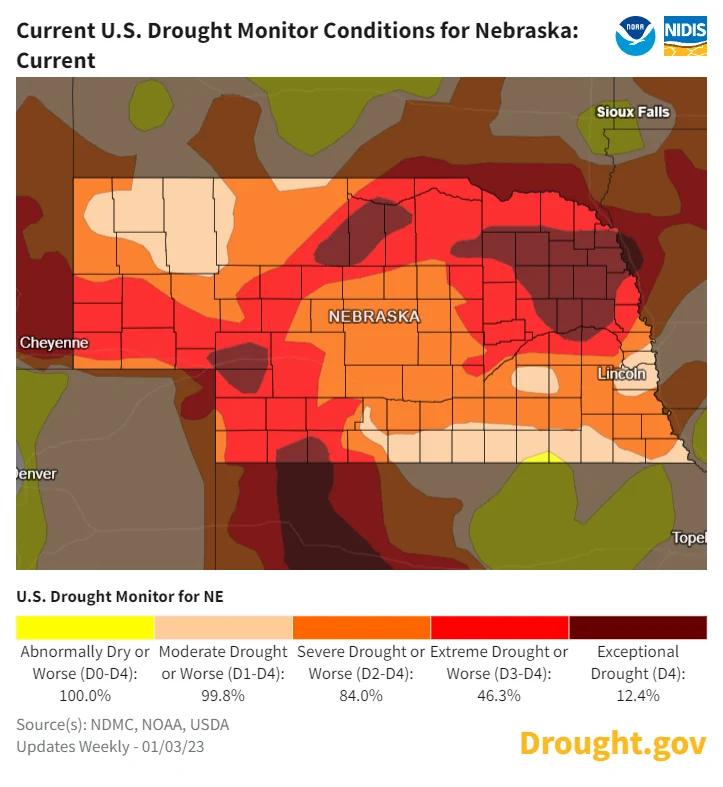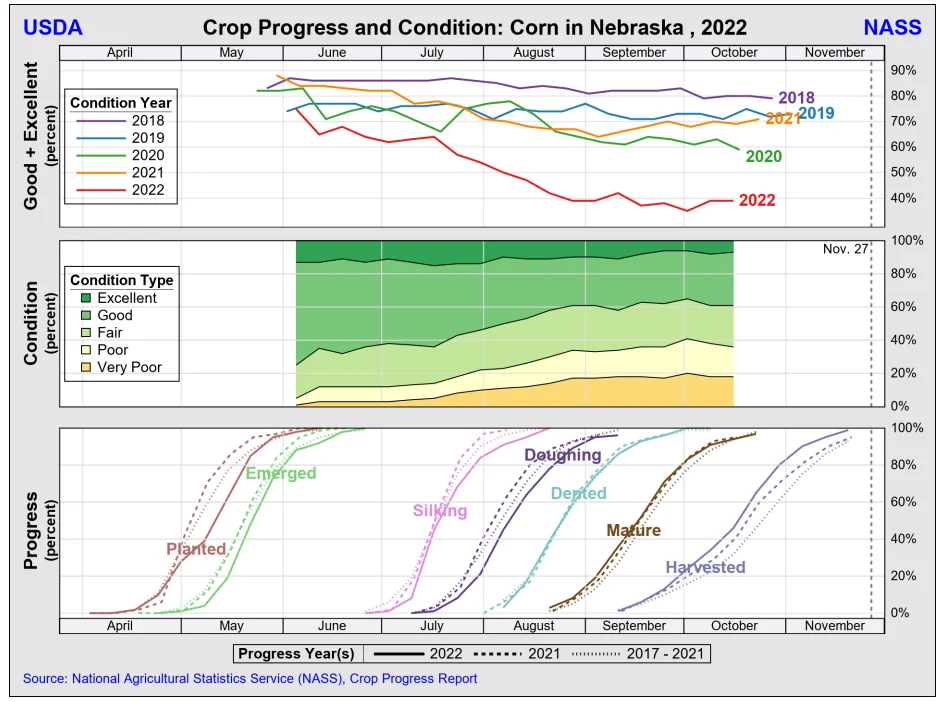As we reflect on 2022, we see a year filled with drastic price increases on inputs due to inflation, price increases in fuel, and supply disruptions as a result of the war in Ukraine. To go along with the drastic price increase with inputs, we experienced the 4th worst drought in Nebraska’s 128-year recorded history, resulting in 22% less production in corn and 21% less production in soybeans (source: University of Nebraska-Lincoln crop production report). There are still favorable prices on commodities, helping offset the underproduction in 2022.

Here is a report of the condition of corn this year in Nebraska. As you can see, the lower quality colors continued to increase throughout the year.

There isn’t a report available breaking down production by irrigated acres versus dryland acres. According to Nick Wells, a south central Nebraska NR Land Agent who farms over 6,000 irrigated acres, there wasn’t much drop in irrigated production. Center pivots did cost more to operate due to increases in fuel costs, but overall irrigated production remained about the same. Dryland production certainly suffered. Some farms didn’t have any production on their crops this year and it was common to hear yields being down 50-75% from last year.
Besides crop production, the drought impacted the cattle market and feed costs, affecting the entire state of Nebraska. Hay prices reached $200/ton on large round alfalfa bales at the end of 2022, compared to $140/ton at the end of 2021 according to the USDA Hay Report. Some ranchers were forced into early weaning and took their calves to auction early because their land didn’t have the production needed to sustain the entire herd.
Kansas was also impacted by the drought. Their forecasted production is projected to be down 32% in corn and 31% in soybeans. “A fair amount of the production that Nebraska did have, is being shipped to central and western Kansas feedlot operations to make up for their lack of production,” said Wells.
Why Buy Land in Nebraska
Nebraska boasts the highest amount of irrigated land in the country, totalling 9.06 million acres as of 2022, per the NRD report on irrigated acres in Nebraska. This high number of acres is directly related to the prevalent water in the state due to the Ogallala aquifer. Access to water has recently bumped Arkansas into 3rd place behind Nebraska and California, surpassing Texas.
The Ogallala aquifer was reported to have 2.92 billion acre-feet of water in it and roughly ⅔ of that amount is believed to be in Nebraska (1 acre-foot = 325,851 gallons). Nebraska has seen rises in water levels of over 84 feet in areas, compared to declines of 234 feet in Texas. Many other states are seeing declining water levels from their sources. Nebraska appears to be doing something right with its public and private programs, including the NRD management and improvements in irrigation efficiency. Nebraska is the largest producer and user of center pivot irrigation, which are among the most efficient irrigation systems available. This is a much more sustainable water use than irrigation systems such as surface irrigation, also known as flood irrigation.
Groundwater irrigation makes up 81% of the total water usage in Nebraska and surface water makes up 13% of total usage. Roughly 10 inches of water are applied per acre annually in the state.
Irrigation plays an important role with agriculture being our state’s largest industry. Economic studies have shown that the value of irrigation contributes to as much as $11 billion annually to Nebraska’s economy. Although, it’s not entirely necessary to have irrigation in all parts of Nebraska. There is some high producing dryland in the eastern part of the state.
Land prices continued to increase throughout 2022 with dryland prices up 20.3% and irrigated ground increasing by 21.7%. Cash rents for dryland and irrigated land only increased 6.5% on both irrigated and dry ground year over year.
We will likely continue to see major investments in Nebraska farm ground for the reasons outlined above. The drought did impact a large portion of the state, but luckily we have the groundwater irrigation we do to help offset the economic impact of the drought.
Sources:
Nebraska 2022 Annual Crop Production Summary
https://www.nass.usda.gov/Statistics_by_State/Nebraska/Publications/Crop_Releases/Annual_Summary/2023/NE-cropsum2301.pdf
Kansas 2022 Annual Crop Production Summary
https://www.nass.usda.gov/Statistics_by_State/Kansas/Publications/Crops_Releases/Annual_Summary/2023/KS-cropsum2301.pdf
Nebraska Direct Hay Report
https://mymarketnews.ams.usda.gov/filerepo/sites/default/files/2935/2021-12-27/541339/ams_2935_00090.pdf
NRD Report on Irrigated Acres in Nebraska
https://www.nrdnet.org/sites/default/files/ne_gw_irrigated_acre_summary_2022.pdf
Ground Water Management Summary
https://www.nrdnet.org/sites/default/files/groundwater_management_summary_2021.pdf
Nebraska 2022 Farm Real Estate Value and Cash Rent
https://www.nass.usda.gov/Statistics_by_State/Nebraska/Publications/Economic_Releases/Cash_Rents_and_Land_Values/2022/NE-crent2208.pdf

